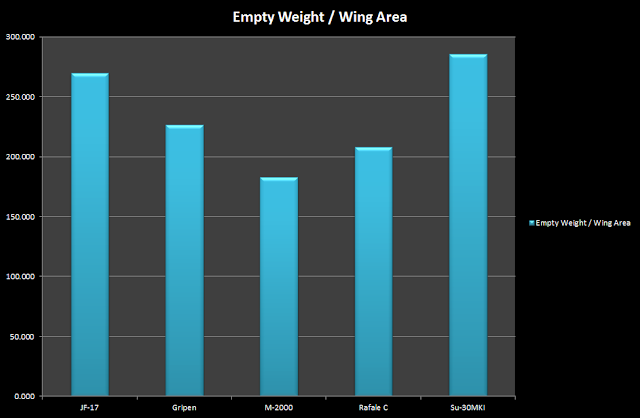A Comparison of the JF-17 & Other Modern Combat Aircraft
23/3/2012
Bismillah arrahman arraheem. From the outset, I want to note that this is a very limited comparison based on a few data elements, namely thrust, empty weight and wing area. The reason for restricting the analysis to these three elements is to keep the discussion as objective as possible given the limited hard data available open source and at the same time focus on some key metrics that give a general perspective of the flight performance of the aircraft in question.
Thrust / Empty Weight
Thrust / Empty Weight is chosen as a substitute to the Thrust-to-Weight Ratio (TWR). The JF-17 scores surprisingly well because of the 98 kN thrust we have used, for which there is clear evidence. However, it must be noted that given the lightweight nature of the JF-17 and the corresponding rapid decrease in TWR given any useful load, the JF-17 TWR would fare less well in reality. However, The data clearly indicates that JF-17 is no slouch and has a reasonably powerful engine to rely on.
Empty Weight / Wing Area
The JF-17 scores poorly in this Empty Weight / Wing Area, which is a metric that substitutes for Wing Loading. Only the Su-30MKI is worse off. Again, the small size of the JF-17 would mean that in reality the wing loading would tend to be higher but given the defensive stance of the JF-17 in comparison to IAF fighters, the JF-17 may not be as badly of. Clearly the Mirage 2000 and Rafale C score very highly in this metric, meaning they would tend to perform better at high altitude and high speed fights (hi-hi) projected to be the future of air dominance war fighting. From that perspective, the Eurofighter would trump the fighters listed on this metric.
What is clear however is that if in fact hi-hi is remotely the future of air warfare, then the PAF needs to augment its JF-17 with something more attuned to the aerodynamics of hi-hi combat. It is noted that the Rafale and the PAKFA, not to mention the Mirage 2000 would prove credible challenges from this perspective.
The J-10B would of course be a very credible fighter to fill that role, but at the same time it may not prove to be a longer term solution. What is worrying is that the models of a JSF type 5th Generation fighter program that are coming out of China, potentially in collaboration with Pakistan, do not show a fighter suited to this role, but rather to the multi-role mold of the JSF. Ideally Pakistan-China should be focusing on a large winged delta or delta-canard that has a few internal AAMs to carry.
The problem with this analysis is of course the presumption of hi-hi combat as the future. In the congested and close proximity airspace of India-Pakistan, hi-hi combat may not always be practically implementable, at least not in its pure form.
Note: The fact that kN is used for thrust, does not effect the analysis because kN is used uniformly across all the planes analyzed and because these ratios are relative ratios for comparative analysis which have no meaningful absolute values. Yes, of course, from a stylistic point of view it would have been better to have uniform metrics.






